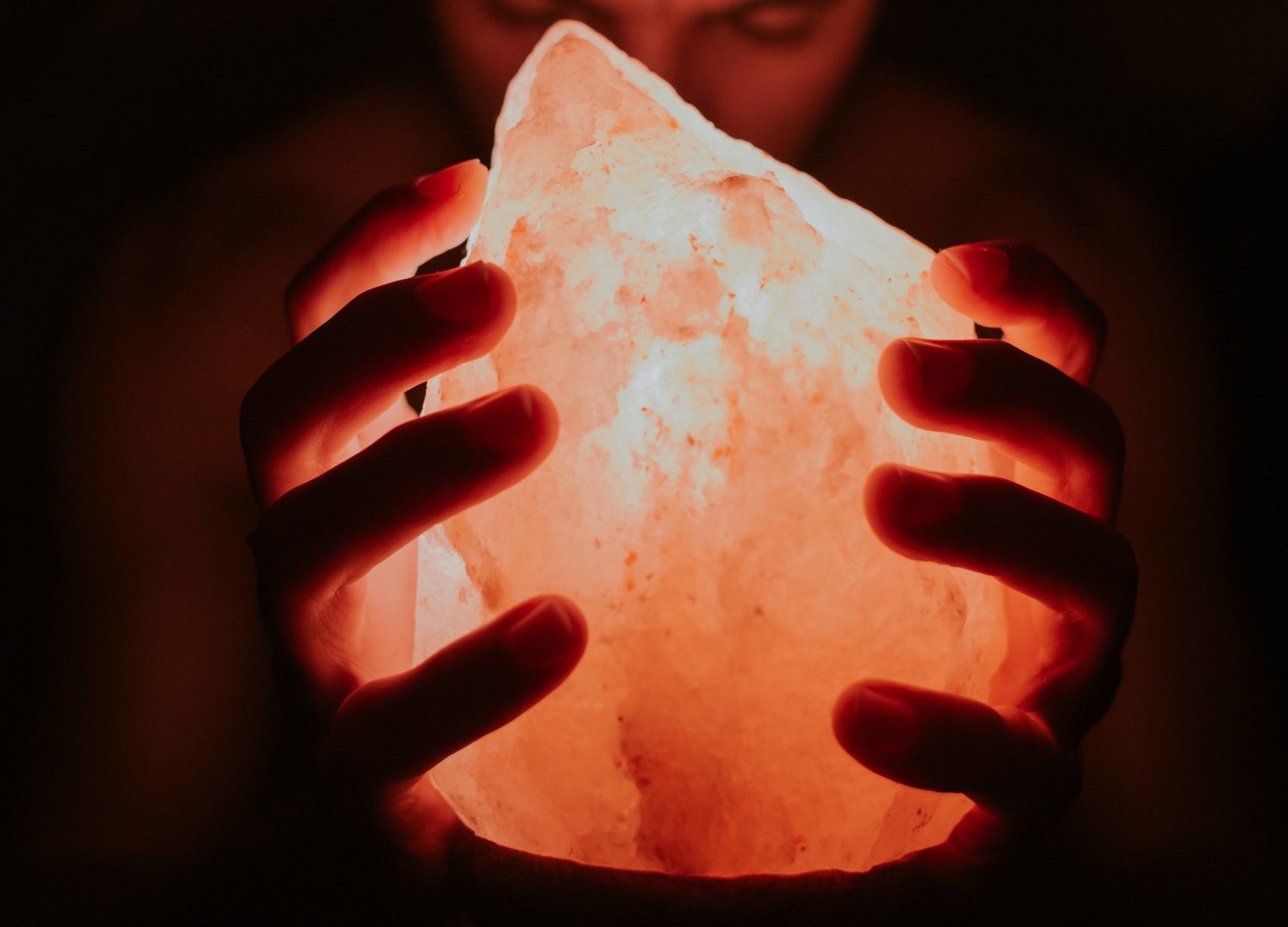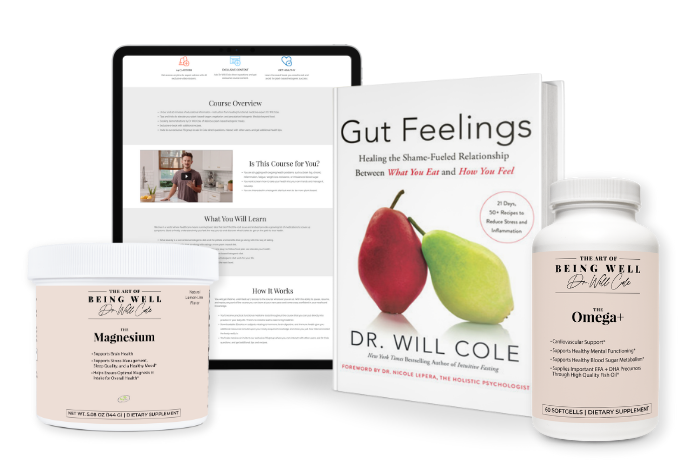The Real—And Not So Real—Benefits of Salt Caves (Halotherapy)

Salt caves, or halotherapy if you’re looking for the manmade version, are one of those buzzy alternative treatments linked to better respiratory, skin, and mental health. I’m a big fan of innovative approaches to support the overall well-being of my patients, but only when the research is solid enough to recommend them.
So… Do salt caves work? Are they good for you?
The potential of halotherapy is definitely there, and anything that makes you feel a little more relaxed is fine by me. From personal experience with salt room therapy, I can say that being surrounded by a room made entirely of Himalayan salt is therapeutic for the mind.
This guide includes everything I’ve found about the real health benefits of salt caves and halotherapy, including where the idea initially came from.
What Is Salt Cave Therapy (Halotherapy)?
Salt cave therapy, or halotherapy, is a holistic practice that involves spending time in a room meant to mimic a real salt cave (without the inconvenience of working in a salt mine). The walls are typically made of Himalayan or sea salt bricks and there's loose, grainy salt underneath your feet.
History
That all may sound like something from another planet, but its roots go back to the 1800s.
Back in the 1840s, a Polish physician named Dr. Feliks Boczkowski noticed that salt mine workers at the Wieliczka Salt Mine near Kraków had better respiratory health than workers in other mines. He decided the salt mine must have therapeutic properties to keep the miners healthy.
As a result, the mine and its special microclimate started attracting visitors looking for relief from respiratory issues like chronic bronchitis. While the cave is popular today with tourists wanting to see its impressive salt sculptures, it’s become a health resort, too, with promising results. (1)
This is the truest form of speleotherapy, or going underground yourself to get those same benefits enjoyed by miners so many years ago. (2)
If you can’t get yourself to Poland or the rest of Eastern Europe, Himalayan salt rooms and halotherapy offerings appear on spa menus all over the United States and a wide variety of international travel destinations. You’ll typically see salt rooms denoted as either active or passive.
Types
Active salt rooms come with a machine called a halogenerator that breaks down and circulates added salt around the room. Passive salt rooms are filled with salt from floor to ceiling and look more like what you’d likely picture if you had to imagine a salt cave.
Both methods are a form of dry salt therapy, in which salt particles or the unique microclimate created in your “salt cave” enter your lungs and wash over your skin.
Wet salt therapy involves wet actions like bathing in salt water or using a salt water flush. In other words, not a cave.
What Research Says About The Benefits Of Salt Caves
In general, the most significant benefits of salt rooms come from the impact of breathing in salt particles and aerosols. But don’t go sniffing your salt shaker at home just yet!
In a salt cave, there is a significant presence of negative ions in the air. (3) More precisely, sodium chloride (salt) splits into its negative and positive ions in these naturally-occurring spaces.
When plentiful negative ions of compounds like chloride are present, several positive benefits can be observed: they kill some disease-causing microorganisms, may help to balance serotonin levels, and reduce particulate matter in the air to improve breathing. (4)
This is a fairly uncharted area of health science, but the initial evidence is very compelling!
Here are a few of the specific pros that salt caves have to offer, backed by research.
1. Your Breathing Might Improve
Inhaling salt can be good for your lung function. Salt particles or aerosols inhaled during halotherapy may reduce inflammation and break down mucus, which could promote clearer breathing.
The research here is evolving, but studies show that regular halotherapy treatments have a positive impact on patients with pulmonary conditions, thanks to that mucosal effect. (5) It makes sense — airways clear of mucus mean better breathing and healthier sinuses.
A small, open-label study tested the effects of 3 weeks of frequent halotherapy sessions on patients with cystic fibrosis, which is associated with significant lung and respiratory issues. The patients collectively experienced an improvement in their sinus problems, suggesting this might be a great additional therapy alongside CF treatment. (6)
Salt’s anti-inflammatory properties may also relieve symptoms from mold-exacerbated conditions like COPD and bronchitis. (7)
If you’re dealing with respiratory conditions caused by chronic inflammation, breathing in some of that salty air may be a solid complementary treatment.
2. Your Skin Might Look And Feel Better
Salt therapy is designed to mimic the microclimate of natural salt caves. That means controlled temperature and humidity levels to create the best environment for the salt to enter your lungs. The humidity in the room can also leave your skin more hydrated than it was before you came in.
Good hydration boosts elasticity and makes your skin more resilient to things like sun damage and visible signs of aging. That’s just one of the salt cave benefits for skin health, though. Halotherapy may even improve some skin conditions like eczema, acne, and psoriasis thanks to the anti-inflammatory, antibacterial, and antimicrobial properties of salt. (8)
Patients with serious rosacea, for example, are often put on antibiotics to reduce flare-ups. Salt therapy sessions can give your skin some time to heal as an alternative therapy before starting a medication regimen.
Whether a salty spa treatment will work for you and your skin needs depends on your overall wellness and what’s at the root of your skin health issues. Those rashes or dermatitis may be the result of a mineral deficiency, allergens, or an immune system condition.
3. Your Allergies Might Be Less Intense
Salt therapy may help your allergy symptoms thanks to its decongesting effects. (9) Inhaling salt-infused air may reduce some of the stuffiness you feel when encountering irritants in your environment or dealing with seasonal allergies.
The potential anti-inflammatory effects of halotherapy can also be a positive for allergy sufferers. Allergic reactions are essentially an inflammatory response. (10) Anything you do to curb chronic inflammation, even if it’s cutting back on alcohol, can create a net positive affect on your symptoms.
4. You May Not Need As Many Medications
Any therapy or alternative treatment that reduces symptoms of existing conditions may reduce your reliance on medications.
Those with sensitivities to steroids and popular allergy medications may find they’re less reliant on their allergy drugs with a regular schedule of halotherapy. I’d call that a win!
That doesn’t mean you should go cold turkey and completely drug-free after your first round of halotherapy. Salt therapy can be one piece toward improved well-being overall, just like natural immune-boosting tools like getting more vitamin D or adopting an anti-inflammatory diet.
If you think it might be time to cut down on your allergy meds, talk to your prescribing physician about what tapering might look like for you.
5. You Might Leave With A Mood Boost
One of my favorite benefits of halotherapy is that it forces you to shut everything else out and think about nothing but the salt. Much like a sauna or visiting a thermal bath, it’s a meditative experience. Think about how you feel after a spa treatment. It’s nice, right?
Spending some uninterrupted time tending to your mental health is good for stress and anxiety, so I’m all for adding salt sessions to your overall wellness plan if it makes you feel good. There’s zero prep involved, too. You can arrive in your most comfortable clothes.
Negative ion therapy of various kinds, at least in the short term, has been noted to positively impact seasonal depression (also known as seasonal affective disorder). (11) However, there have been no human studies on the impact of halotherapy, in particular, on mood, so this should be taken with a grain of… well, salt!
Salt therapy rooms also give you some time to relax in clean air. (12) Since they’re meant to mimic the natural microclimate of salt caves, they come without the risk of pollutants entering your lungs in less pristine environments.
Are There Risks?
Salt therapy is generally safe for most healthy adults, but it’s important to know the potential risks and side effects involved in the sessions:
- You might cough more. The clearing effects on your respiratory system can cause more coughing after your session, but this typically goes away within the day.
- It may irritate your skin. I know this is the opposite of what I shared on the possible good salt can do for your skin, but those micro-particles can also have a drying effect on some people.
- It may interact with medications. This is possible with any alternative treatment. Ask your prescribing doctor for advice on whether or not your medications may be affected by salt cave therapy.
Avoid salt therapy if you’re dealing with any open sores or active infections, contagious illnesses, high blood pressure, or heart conditions.
It’s also important to do your research before booking a halotherapy appointment. Look for spas or wellness centers overseen by a healthcare provider, if possible.
If you’re interested in a holistic approach to optimal health, I can help you get there. Schedule a health consultation with me today to kickstart your health journey.
READ NEXT: What A Salt Water Flush Is + How It Can Benefit Your Health
FAQs
The biggest different between traditional salt caves and halotherapy is that salt caves are natural. Halotherapy is an artificial experience. Even the highest quality spa won’t replicate what it’s like to sit inside a real salt cave with 100% accuracy, but the best ones get close.
The optimal number of halotherapy sessions depends on your existing health conditions and your lifestyle. Budget can factor in, too. Often, newcomers to salt therapy start with more frequent sessions of 2-3 times per week with maintenance sessions up to 2 times per month.
A typical halotherapy session lasts between 30-45 minutes. This is usually what’s offered at a halotherapy spa or salt cave in a travel spot.
Salt caves prompt relaxation and introspection, which can be a spiritual experience for some. The peaceful atmosphere supports mindfulness, meditation, and a sense of connection with yourself and what’s happening around you. You may leave the space with a sense of inner peace.
There is quite a bit of evidence-based potential about the benefits of using salt rooms, but some claims can be overblown. Halotherapy is not a cure-all or complete detox, but an alternative treatment to reduce respiratory symptoms and skin health conditions and provide a calming environment in which to rest.
Salt therapy should generally be used as a secondary treatment, no matter what ails you. It’s a great aid to other holistic remedies for a healthier body, but it isn’t a replacement for a diet filled with whole, nutrient-dense foods, an active lifestyle, targeted supplements to address your health concerns, and a healthcare provider who offers personalized support.
View More At Our Store
Purchase personally curated supplements
and Dr. Will Cole’s books!

- Zając, D., Russjan, E., Kostrzon, M., et al. (2020). Inhalations with brine solution from the 'wieliczka' salt mine diminish airway hyperreactivity and inflammation in a murine model of non-atopic asthma. International Journal of Molecular Sciences, 21(13), 4798.
- Lăzărescu, H., Simionca, I., Hoteteu, M., et al. (2014). Speleotherapy - modern bio-medical perspectives. JML Journal of Medicine & Life, Spec No. 2(Spec Iss 2), 76-9.
- Antonovici, M. O., Sandu, I. G., Vasilache, V., Sandu, A. V., Arcana, S., Arcana, R. I., & Sandu, I. (2023, July). Implications in Halotherapy of Aerosols from the Salt Mine Targu Ocna—Structural-Functional Characteristics. In Healthcare (Vol. 11, No. 14, p. 2104). MDPI.
- Jiang, S. Y., Ma, A., & Ramachandran, S. (2018). Negative air ions and their effects on human health and air quality improvement. International journal of molecular sciences, 19(10), 2966.
- Barber, D., Malyshev, Y., Oluyadi, F., et al. (2022). Halotherapy for chronic respiratory disorders: from the cave to the clinical. Alternative Therapies in Health and Medicine, 28(3), 52-56.
- Achkar, M. A., Geller, D. E., Slaney, A. P., & Layish, D. T. (2015). Halotherapy in patients with cystic fibrosis: A pilot study. Int J Respir Pulm Med, 2(009).
- Wasik, A.A. & Tuuminen, T. (2021). Salt therapy as a complementary method for the treatment of respiratory tract diseases, with a focus on mold-related illness. Alternative Therapies in Health & Medicine, 27(S1), 223-239.
- Chereshnev, V.A., Barannikov, V.G., Kirichenko, L.V., et al. (2016). The new directions in the physiotherapeutic applications of the natural potassium salts of the Western Ural. Vopr Kurortol Fizioter Lech Fiz Kult, 93(6), 21-26.
- Lazarescu, H., Simionca, I., Hoteteu, M., et al. (2014). Surveys on therapeutic effects of "halotherapy chamber with artificial salt-mine environment" on patients with certain chronic allergenic respiratory pathologies and infectious-inflammatory pathologies. Journal of Medicine and Life, Spec No. 2(Spec Iss 2), 83-7.
- Bellanti, J.A. & Settipane, R.A. (2019). Inflammation and allergic disease: An irrefutable combination. Allergy & Asthma Proceedings, 40(1), 1-3.
- Terman, M., & Terman, J. S. (1995). Treatment of seasonal affective disorder with a high-output negative ionizer. The journal of alternative and complementary medicine, 1(1), 87-92.
- Zajac, J., Bojar, I., Helbin, J., et al. (2014). Salt caves as simulation of natural environment and significance of halotherapy. Annals of Agricultural & Environmental Medicine, 21(1), 124-127.
The information on this website has not been evaluated by the Food & Drug Administration or any other medical body. We do not aim to diagnose, treat, cure or prevent any illness or disease. Information is shared for educational purposes only. You must consult your doctor before acting on any content on this website, especially if you are pregnant, nursing, taking medication, or have a medical condition.
Our content may include products that have been independently chosen and recommended by Dr. Will Cole and our editors. If you purchase something mentioned in this article, we may earn a small commission.

BY DR. WILL COLE
Dr. Will Cole, DNM, IFMCP, DC is a leading functional medicine expert who consults people around the globe, starting one of the first functional medicine telehealth centers in the world. Named one of the top 50 functional and integrative doctors in the nation, Dr. Will Cole provides a functional medicine approach for thyroid issues, autoimmune conditions, hormonal imbalances, digestive disorders, and brain problems. He is also the host of the popular The Art of Being Well podcast and the New York Times bestselling author of Intuitive Fasting, Ketotarian, Gut Feelings, and The Inflammation Spectrum.

Gut Feelings
Healing The Shame-Fueled Relationship
Between What You Eat And How You Feel



